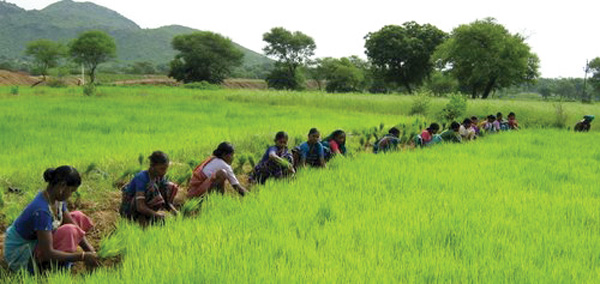Building a New India
Radha Mohan Singh
To improve the economic condition of the farmers, Hon’ble Prime Minister Shri Narendra Modi has set a target. The goal is to double the income of farmers by 2022. For the first time, a prime minister has put such a target in front of the nation for the welfare of farmers. Under the leadership of the Prime Minister, the Agriculture Ministry is working to achieve the target by 2022. The Ministry is working sincerely and honestly to fulfill our Prime Minister’s dream. To double the farmer income, a large number of officials and farmers have been taking a pledge at events organized by the KVK since August 15, 2017.
The Ministry is working on a Seven-point Strategy to double farmers’ income by 2022. We are working in a planned manner. The first point is to Increase Productivity. It broadly means focusing on irrigation with adequate resources and that is why we have increased the irrigation budget.
India has 142 million hectares agriculture land, out of which only 48% land is under institutional irrigation. With the objective of providing water to every field, Pradhan Mantri Krishi Sinchai Yojana has been launched on July 1, 2015, and, to provide an end-to-end solution in irrigation supply chains, water resources, network distribution as well as farm level application. We have adopted an overall approach, which combines irrigation with water preservation. The objective is More Crop Per Drop. In addition, the aim is to complete pending medium and large irrigation projects on the priority basis in the next four years. Water harvesting, management, and watershed development projects have been put on the fast track.
The Second point is the Effective use of Inputs, which means increasing production through improved seeds, planting materials, organic farming, Soil Health Card and other schemes. Under this, we are focusing on nutrients and improved seeds. For the first time, a scheme has been launched for organic farming. Similarly, the Government has curbed illegal use of urea and ensured its adequate supply through Neem Coated Urea scheme. In addition, Soil Health Card Scheme has helped in reducing the cultivation cost and increased the production by curbing misuse of fertilizers. Farmers are also getting timely information and advisory services through new technologies such as space technology and online and telecom facilities like Kisan Call Centre and Kisan Suvidha App.
The Third point is Reducing Post-Harvest Losses. One of the biggest problems of the farmers is storage after harvesting as a result they are forced to sell their products at a lower cost. Therefore, the government is encouraging farmers to use warehouses and avoid distressed sales. Loans against negotiable warehouse receipts are being provided with interest subvention benefits. To protect farmers from losses, the government is focusing on storage facilities and integrated cold chains in rural areas.
The Fourth point is Value Addition. The government is also promoting quality through food processing. Our government has launched Pradhan Mantri Kisan Sampada Yojana. Under this scheme, food-processing capabilities will be developed by working on the forward and backward linkage of agro processing cluster, which will benefit 20 lakh farmers and create employment opportunities for about 5, 00,000.
The Fifth point is Reforms in Agriculture Marketing.We want to ensure that a large part of the profit reaches the farmer and the role of intermediaries minimizes. Therefore, the Government is emphasizing on the need of reforms in agriculture marketing. e-NAM has been launched with three reforms and so far, 455 mandis have been linked to this platform. Online trading has begun on various mandis. In addition, the government has circulated model Agricultural Produce Market Committee (APMC) Act, which includes private market yards and direct marketing. Farmers are also being organized as Farmer Producer Organization. This not only helps them in achieving economy of scale but also increase their bargaining power.
The Sixth point is Risk, Security, and Assistance. The government has initiated Pradhan Mantri Fasal Bima Yojana (PMFBY) to reduce the possible risks. The scheme is a security shield for farmers’ income. The lowest rate has been fixed for Kharif and Rabi crops. Maximum rate is 2% and 1.5% respectively. The scheme covers standing crops as well as pre-sowing to post-harvesting losses and 25% of the claim is settled immediately online. Under PMFBY many states have started using remote sensing technology and drones to estimate losses and settle claims without much delay. New technologies like smartphones are being used for harvesting. From this Kharif season, the farmers can avail customer service center and online banking facilities to deposit their premiums.
The Government has revised the norms for assistance from SDRF and NDRF. Now, the government is providing compensation if at least 33% of the crop is damaged. Compensation amount has been increased 1.5 times.
To reduce climate change impact, various tolerant species and animal species have been developed. Contingency plans for affected districts have also been prepared.
The Seventh and the last point is Allied Activities. Under this, we are focusing on horticulture, dairy, poultry, beekeeping, fisheries, white revolution, blue revolution, agroforestry, integrated farming and rural backyard poultry development to increase the income of the farmers. We will increase the income of farmers through allied activities. Partially, it will be done through poultry, beekeeping, animal husbandry, dairy development, and fishery.
We are encouraging farmers to utilize uncultivated areas for peripheral and boundary plantation to grow trees for wood and to produce solar cells.
We are also emphasizing on horticulture, agro-forestry, and integrated agriculture.
(The writer is Union Minister of Agriculture, GoI)


